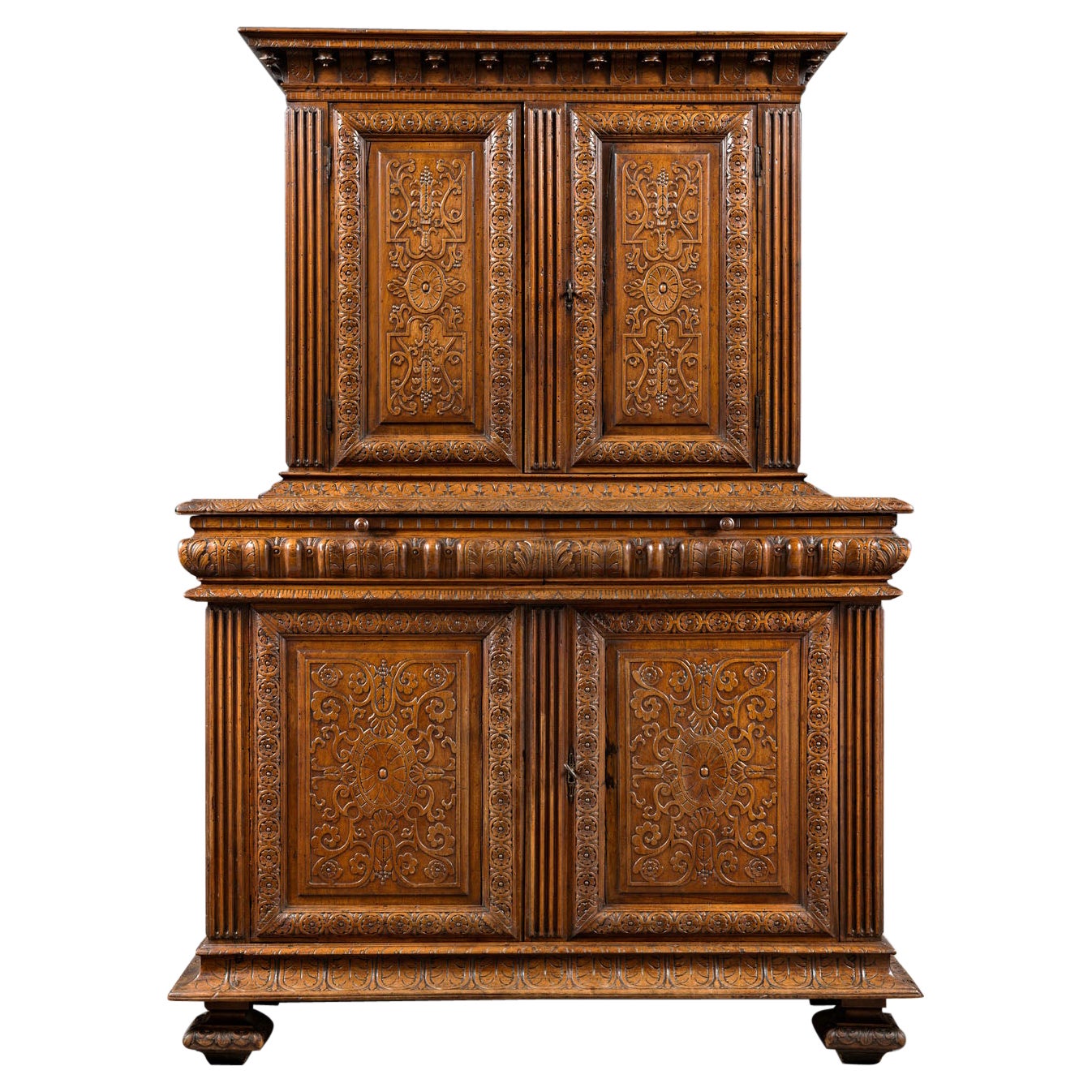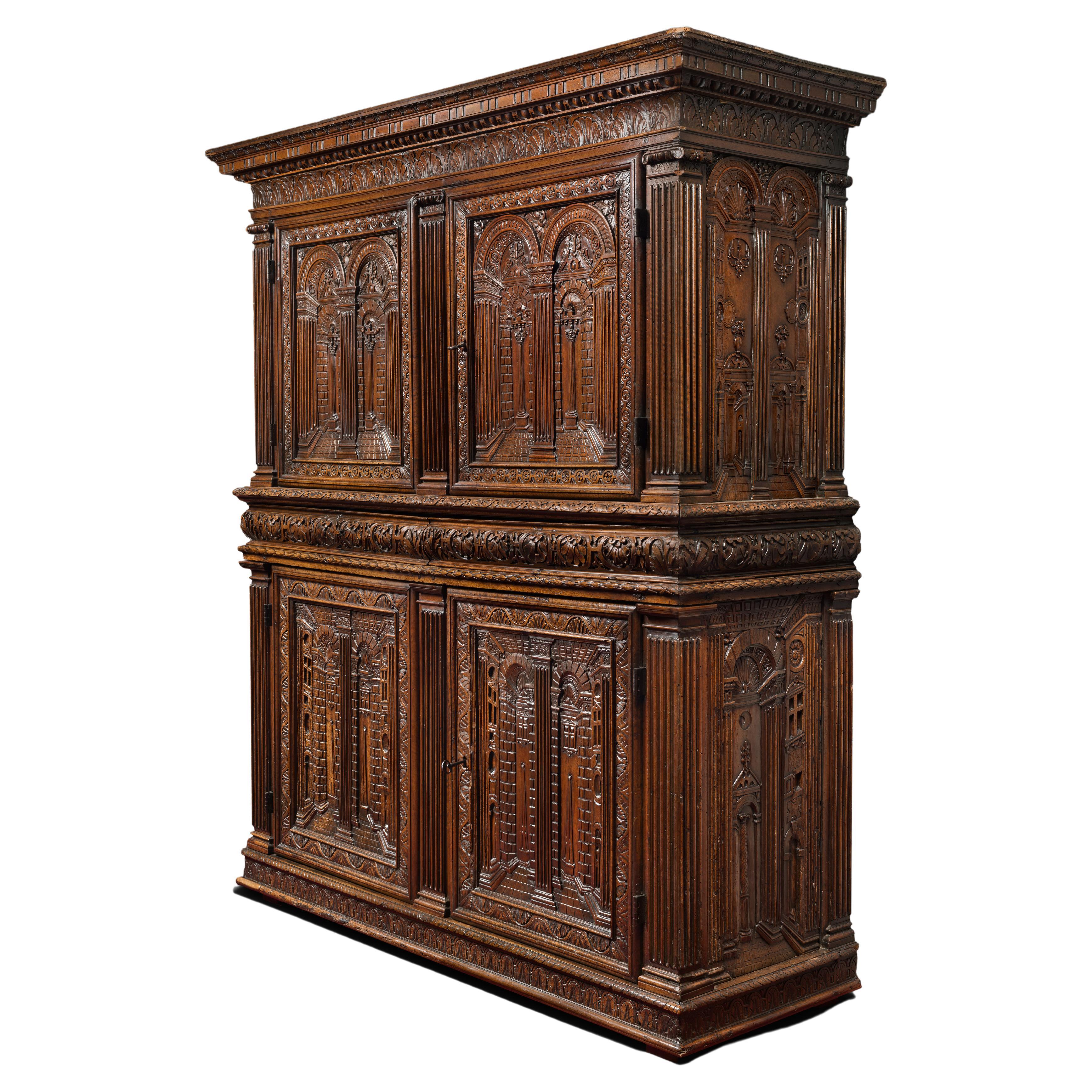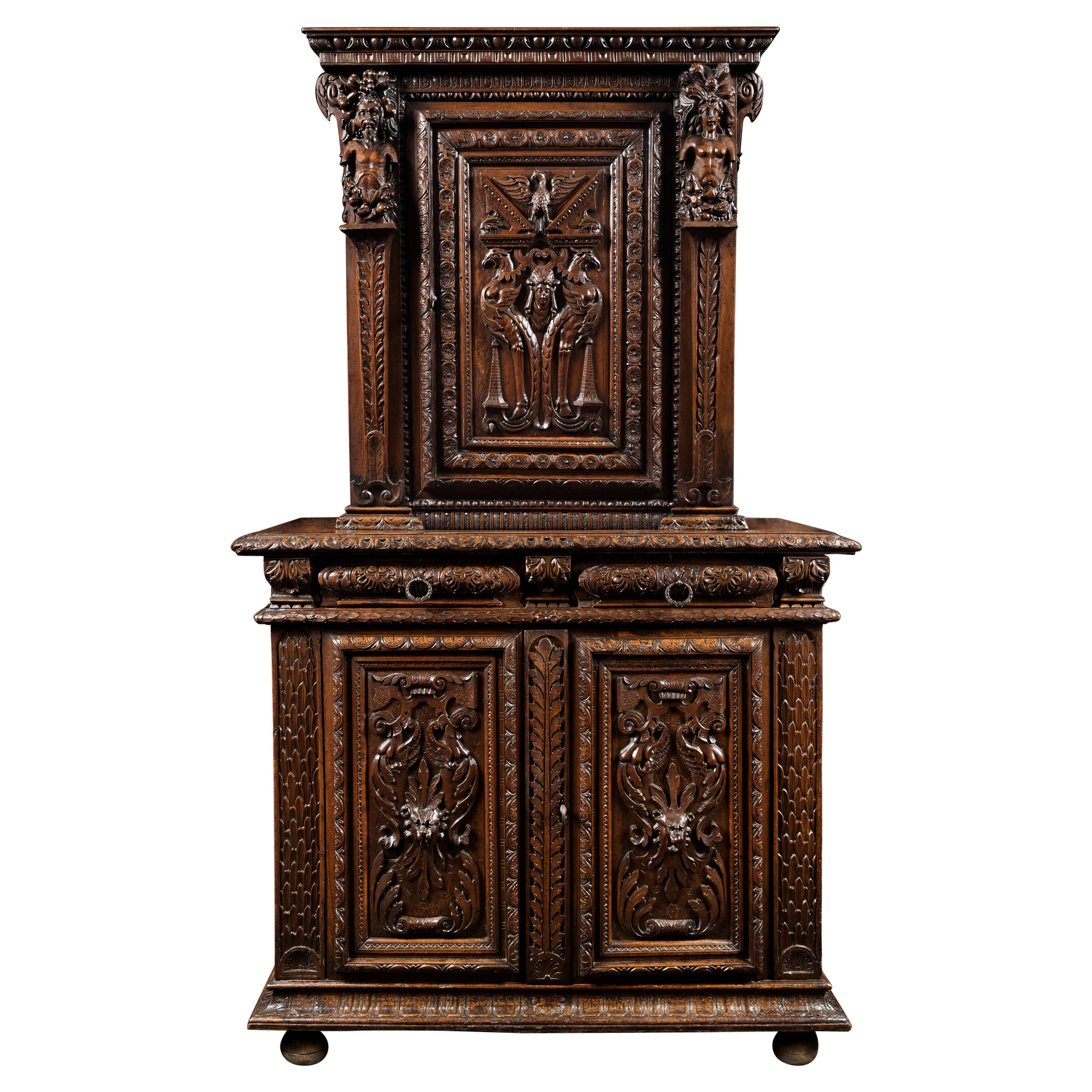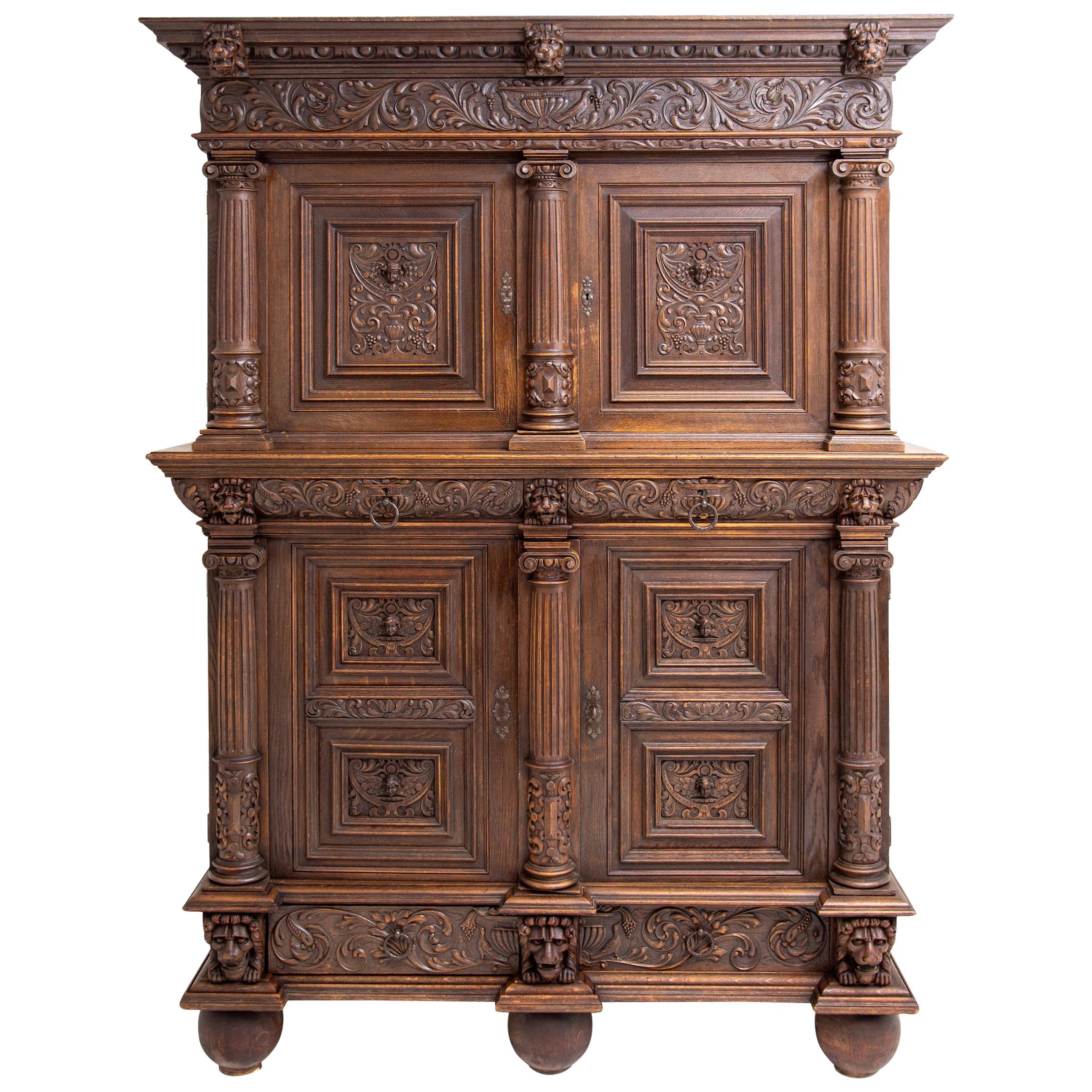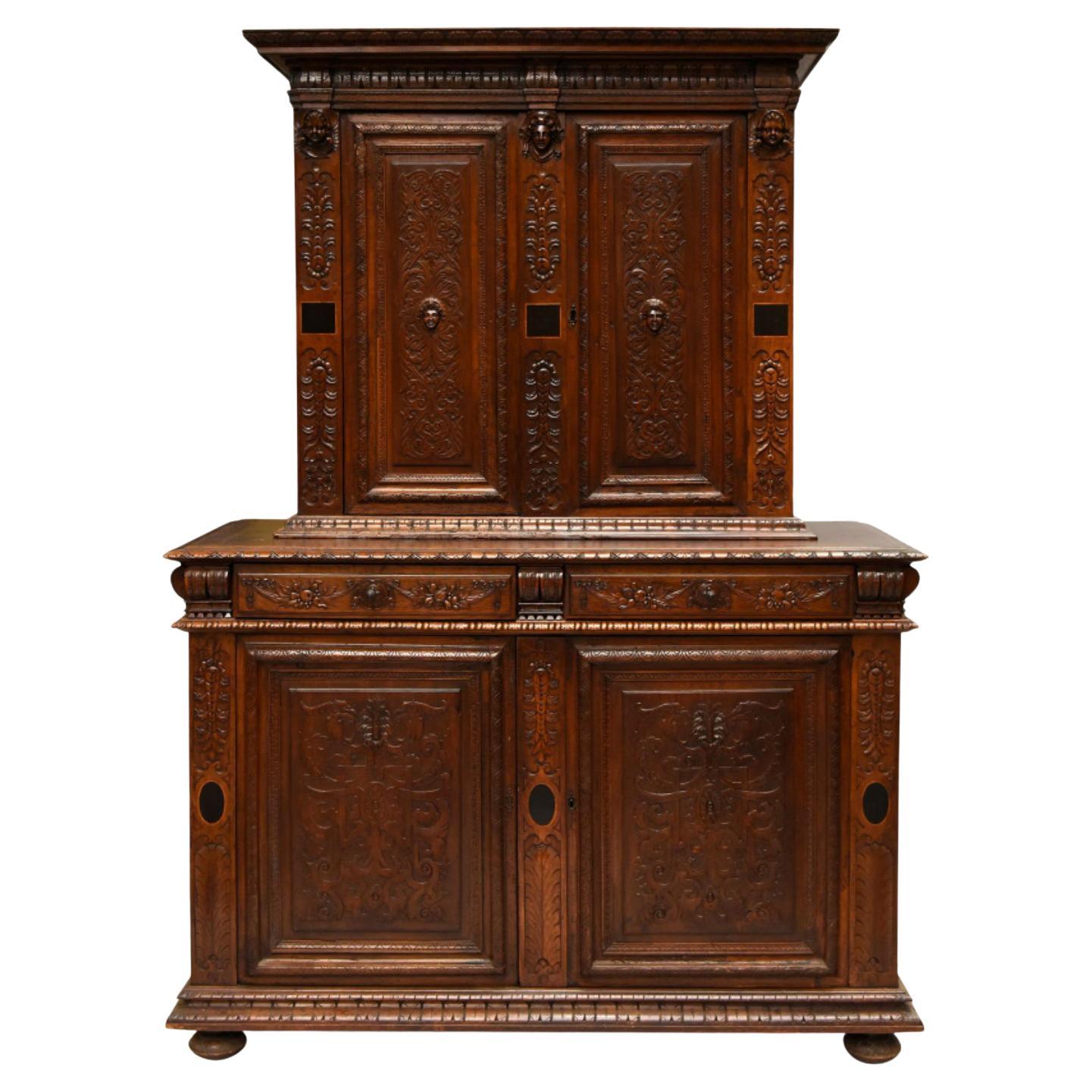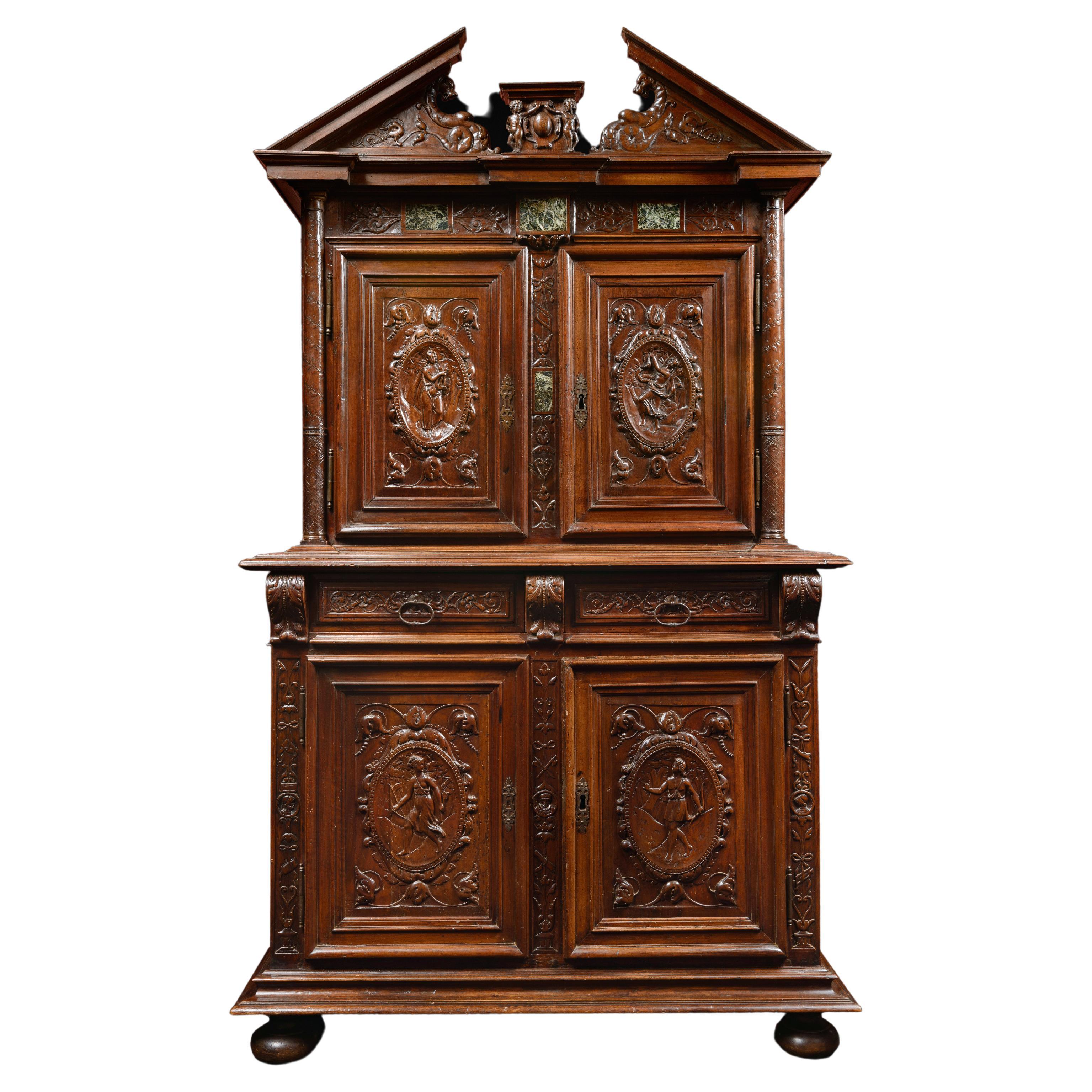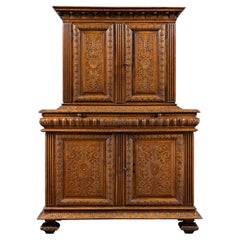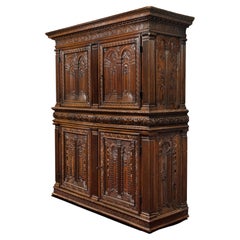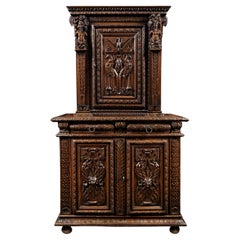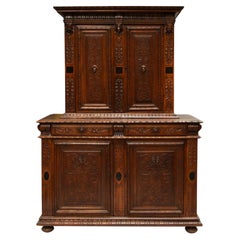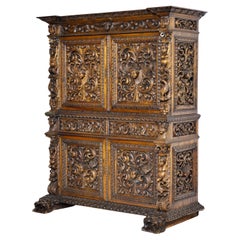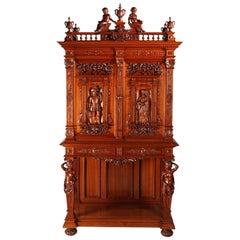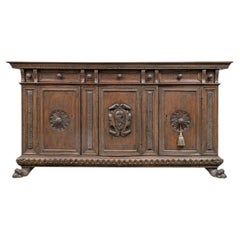Items Similar to Fontainbleau Renaissance Cabinet Bearing the Dodieu’s Family Coat-of-arms
Want more images or videos?
Request additional images or videos from the seller
1 of 6
Fontainbleau Renaissance Cabinet Bearing the Dodieu’s Family Coat-of-arms
$53,916.46
£40,129.86
€45,000
CA$73,852.07
A$82,139.63
CHF 42,890.76
MX$999,551.88
NOK 547,780.46
SEK 513,721.43
DKK 342,569.29
Shipping
Retrieving quote...The 1stDibs Promise:
Authenticity Guarantee,
Money-Back Guarantee,
24-Hour Cancellation
About the Item
Fontainebleau renaissance cabinet bearing the Dodieu’s family coat-of-arms
Origin : ILe De France, School of Fontainebleau
Period : Second French Renaissance, Around 1560-1580
Light coloured walnut wood, egg-shell pastiglia, inlay of ebony
Good condition, usual restaurations
Everything in this cabinet brings to mind the rigour and elegance in vogue during the reign of the French king Henri II. This Renaissance cupboard finds its direct inspirations in works from Fontainebleau, made during the second half of the 16th century. Its strong structure is conceived as an imitation of architecture as we can see through the use of Corinthian columns and with the refined pediment.
Each drawers, the pediment and the lateral sides are enriched with blackened wood and pastiglia inlays. This technique originates from Italy and so are the delicate scroll motifs.
The lower body opens with two door-leaves and two drawers and stands on a moulded plinth with four bun feet.
The Second French Renaissance and the School of Fontainebleau
During the reign of the French king Henri II appears a style of furnitures strongly influenced by architecture. This taste for balance sets the bases of a French art. The cupboard, as a model of a building’s facade, uses modillions, feather-quills, columns, cornice and curved pediment. These combinations of architecural shapes is also applied to the ornaments : within the architectural rigour the decorative effect is very much alive.
The uprights of the lower body are adorned with veneered blackened wood motifs wisely located. They evoke the carpenters activities of the first Italian artists in France, famous for their marquetry flooring.
Within moulded frames each body’s door-leaves bear low-relief carvings divided in three areas. The door-leaves are centered by female figures barely dressed with a floating drape and facing each other in a pastoral landscape.
On the left Flora, the allegory of Spring, holds a bouquet and a cornucopia full of flowers.
On the right Ceres, the allegory of Summer and fertility, holds a cornucopia full of fruits and sheaves of wheat.
Above them are lying two female figures facing each other.
On these depictions Summer and Spring appearances match their traditional iconographies, defined through time and eventually written down by the author Cesare Ripa in his Iconologia published in 1603.
The theme of the seasons is very much used by the School of Fontainebleau but by reinventing the models : undressing the female figures -except Spring the other seasons were always depicted dressed- higlighting the supple lines of the bodies perfectly inscribed in their frames.
The influence of Jean Goujon is seen as much by the panel composition than by the themes chosen (seasons, nymphs, goddesses) or by the execution ; law relief figures, elongated canon, dancing moves.
Only the central motif between the drawers of the belt brakes this logic of representation, a strong lion’s head in high relief. Located in the center of the cabinet’s facade it emphasized the modillion’s volume place at the same height.
Mythological motifs also find their source in Fontainebleau’s production. Fantastic beasts, eagles about to fly off with their wings restrained by the rectangular frame.
The cabinet’s structure, its proportions, the design of the ornamental spaces match the models defined in Fontainebleau. The architectural composition is lightened up thanks to two important columns and to the ternary division of the decor. On the lower body the uprights are enriched with cartouche centered by sphinxes.
Sphinxes
Enigma has a name, a shape and a face inherited from antic mythologies. From Egypt to Greece the sphinx symbolizes serenity, vigilance, intelligence and voluptuousness. Beast with a female head and a lion’s body the sphinx seduced the Fontainebleau Renaissance. Indeed these artists were not imitating nature but interpreting, building on abstract rules with the pursuit of ideal beauty guiding them.
The crouched creature with its elongated neck bent backwards in an elegant curve is depicted with a regular face and large breast, attributes of open feminity, mixing erotism and preciousness.
Conclusion
Its decor and its division of the ornamental space are characteristic of the Second French Renaissance.
The cabinet is topped with a broken triangular pediment. In the center two columns frame a highly carved coat of arms. Above an entablature carries a pediment with volutes.
The door-leaves bear goddesses, female figures, fantastic beasts inspired by antiquity with a hint of Italian art. Female figures stand elegantly amidst their dancing drapes in a way close to Fontainebleau mannerism. This type of allegorical depictions of seasons was particularly in vogue during the second half of the 16th century. The charm of these figures seduced the patrons.
Perfect testimony of the French art with its refined decor, the rigour of its proportions and the suppleness of its crowning this cabinet can be compared with cupboards ordered to furnish royal palaces and castles. A time during which the furnishing of Chambord, Saint-Germain or Fontainebleau castles kept the worshops very busy.
This cabinet was beautifully made in the Loire Valley during the second half of the 16th century.
DODIEU Family
France, Lyon
The earliest record of the name DODIEU dates back to 1269. This year Thomas and Guillaume Dodieu sign the Truce between the Chapter of Lyon and the citizens.
All along the line, this family keeps a certain political and religous importance with the elections of many bishops and governors.
To draw a link between our cabinet and a member of the Dodieu’s family we have to reach the year 1524 and the 8th degree.
Claude Dodieu, was lord of Rivas and second son to Jacques Dodieu, the king’s secretary. Councilor of the court in 1524 he was promoted master of requests in 1529. Claude Dodieu was also sent as ambassador in Rome and followed emperor Charles V in Austria, in Spain, in Africa, in Naples and in Rome.
Claude Dodieu’s political status allowed him to attend the consecration of the queen Catherine de’ Medici at the Basilique Saint Dénis in 1549. He stays in Paris and have a seat to the 1557 State Assemblies.
The following year Claude Dodieu died in Paris and was buried in the 4e arrondissement, inside the church of the Pères Célestin nowadays destroyed. It was the second most important royal necropolis -after Saint Dénis- where many princes had been buried attesting the prominence of Claude Dodieu.
Claude Dodieu may have been the patron of our cabinet.
- Dimensions:Height: 95.08 in (241.5 cm)Width: 53.75 in (136.5 cm)Depth: 23.04 in (58.5 cm)
- Style:Renaissance (Of the Period)
- Materials and Techniques:
- Period:
- Date of Manufacture:circa 1560-1580
- Condition:
- Seller Location:Saint-Ouen, FR
- Reference Number:1stDibs: LU3115329553922
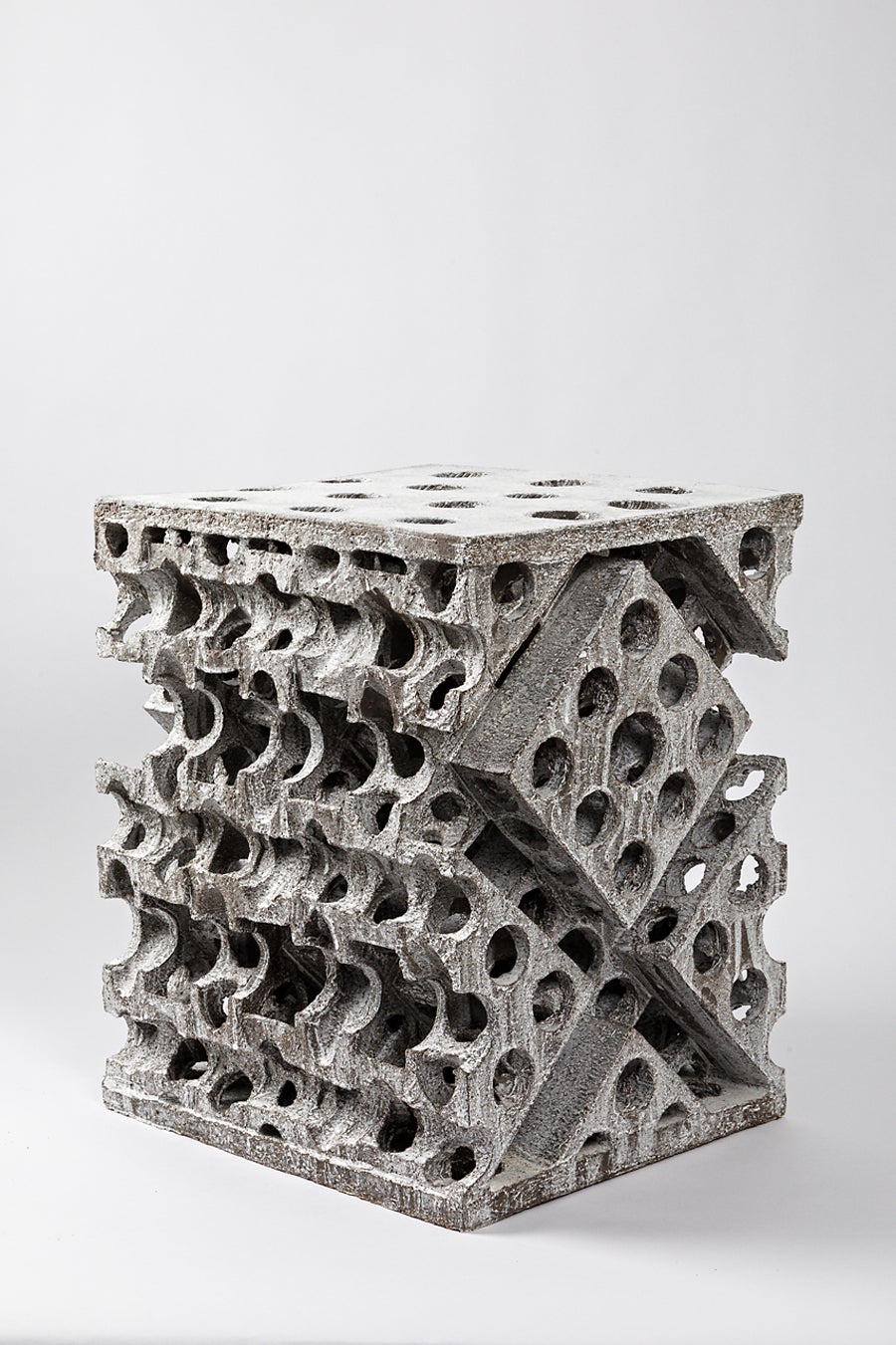
About the Seller
5.0
Vetted Professional Seller
Every seller passes strict standards for authenticity and reliability
Established in 2016
1stDibs seller since 2017
189 sales on 1stDibs
Typical response time: 3 hours
- ShippingRetrieving quote...Shipping from: Saint-Ouen, France
- Return Policy
Authenticity Guarantee
In the unlikely event there’s an issue with an item’s authenticity, contact us within 1 year for a full refund. DetailsMoney-Back Guarantee
If your item is not as described, is damaged in transit, or does not arrive, contact us within 7 days for a full refund. Details24-Hour Cancellation
You have a 24-hour grace period in which to reconsider your purchase, with no questions asked.Vetted Professional Sellers
Our world-class sellers must adhere to strict standards for service and quality, maintaining the integrity of our listings.Price-Match Guarantee
If you find that a seller listed the same item for a lower price elsewhere, we’ll match it.Trusted Global Delivery
Our best-in-class carrier network provides specialized shipping options worldwide, including custom delivery.More From This Seller
View AllExceptional Renaissance Cabinet from Lyon
Located in Saint-Ouen, FR
Exceptional Renaissance Cabinet from Lyon
Origin: Lyon, France
Period: 1540-1580, Second French Renaissance
Measures: Height: 188 cm
Length: 132 cm
...
Category
Antique 16th Century Cabinets
Materials
Walnut
Important Renaissance Cabinet from Lyon 'France' with a Decor of Perspectives
Located in Saint-Ouen, FR
As soon as 1540 France's second Renaissance is in the making, intimately linked to the rediscovery of the Antique world. The development of the printing and engraving industry allows the spread of artworks and models in many cities and countries. The Italian influence can be perceived in every artistic field. While the French king entrust the most talented Italian artists with major projects such as Il Rosso or Primaticcio in Fontainebleau, French artists also travel to Italy to form themselves to this new style. In Italy they get acquainted with the work of Leo Battista Alberti the first to theorize perspective (De Pictura, 1435-36) and architecture (De re oedificatoria, 1541). Those two publications would have a revolutionary impact on arts.
Furniture is marked by the work of the most famous Italian architects of the time as well as French architects. Indeed Philibert de l'Orme competes with Alberti and by the end of his life publishes several treaties including one devoted to a theory of architecture (1567). Unfortunately he would not live to complete the second volume. In this treaty he expresses his interest for mathematical norms applied to architecture, copied from the Antique. His journeys in Italy allowed him to accumulate the most sophisticated references. Jean Bullant, another architect of great talent also theorizes his practice. He establishes rules characterizing Greco-Roman art staying faithful to Vitruvius.
Following this new inspiration the structure of furniture evolves. From then on appear columns, capitals, cornices, friezes and architraves. The ornamentation uses this inspiration as well with egg-and-dart, palm leaf and rose adorning the most beautiful pieces.
In Lyon, crossroad where meet merchants from everywhere those new experiments are welcomed. Lyon florishing printing industry allows the spreading of models and treaties essential to the artist's work. Thus the first publication of Vitruvius' De Architectura in France would be printed in Lyon in 1532.
Artists from Lyon rediscover and familiarize themselves with the Antique knowledge very early. They adopt those new ideas and use them in their own creations. Lyon cabinet-makers re interpret Antique architecture and Italian Renaissance palaces to give their pieces a pure and harmonious architectural structure. Grooved pilasters are particularly favored. They are topped by capitals of diverse orders always respecting the sequencing with simpler ones for the lower levels and the richest ones on the higher levels. As for the ornamentation, one of the great distinctiveness of Lyon workshops remains the architectural perspective illusions, drawing inspiration from Tuscany.
True masterpiece of the Second French Renaissance this important cabinet illustrates Lyon workshops' taste for fine Italian architecture inspired by Antiquity. An architectural perspective of great quality is treated in symmetry on each panel.
This two-bodied cabinet without recess stands on four rectangular feet. The base comprises a molding, a palm leaf frieze and is bordered by a braid.
The lower body is divided by three grooved pilasters with Tuscan capitals framing two door-leaves. The two panels are encircled by a moudled frame with palm leaves. They are finely carved with a decor of fantasized architecture depicting an Italian Renaissance palace erected symmetrically on each side of a grooved pilaster. On the ground floor a door opens through a stilted arch while the stories are opened with mullioned windows, dormers and occuli. Two large pegged-boss cladded pillars support the entablature enriched by a palm leaf frieze upon which stands an arch whose coffered intrados is centred by a rose. Behind this arch a pyramid appears, standing in front of a second facade with a window topped by a broken curvilinear pediment under a cul-de-four with a shell.
The checker flooring gives depth to the low-reliefs creating vanishing points structuring the panels and guiding the eye of the observer.
A thin laurel braid highlights the belt of the cabinet where are located two drawers. Their facades are adorned by palm leaves in hoops.
The upper body is encircled with palm leaves. The same ternary division as in the lower body appears. However, the pilasters are topped by Ionic capitals with volutes and egg-and-dart. The door-leaves are framed with flowers. On the panels the artist has designed another architectural decor. On the foreground open two arches on top of grooved pilasters with rectangular capitals adorned with palm leaves. The arches are enriched with braids and the coffered intrados bears a decor of roses. The spandrels also bear a flower decor. In the background another arcature hosts a fluted grooved column topped with double basket acanthus capital, characteristic of Corinthian order. The triangular pediment is interrupted by a choux bourguignon.
A large cornice crowns the cabinet. It stands on pilasters and forms an entablature comprising a palm leaf frieze and an egg-and-dart, triglyph and palm leaf cornice.
The cabinet's sides have also been carefully considered. The lower body's panels are enriched with an arch rising above a broken pediment portico hosting a twisted column. Flowers garnish the spandrels. An architectural facade completes the decor. The upper body's panels present two arches supported by a facade opened with dormers and mullioned windows as well as cartouches (one bears the inscription 1580 dating the cabinet) suggesting the interior of an Italian Renaissance palace, confirmed by the chandeliers. The flooring leads our gaze to a second arch with a broken curvilinear pediment where stands a flower vase. This arch opens onto a perspective of another facade along a road.
Inside the cabinet, on the lower body door-leaves appear two designs. On the right door is depicted a Crucifixion. Saint Mary and Saint John flank the Christ on the cross. In the bottom part is inscribed « Dure uiator abis nihil haec spectacula curas / Pendenti cum sis unica cura Deo. / Tota suo moriente dolet natura Magistro. / Nil qui solus eras caussa dolenda doles. ». The signature [Christoff Swartz Monachiensis pinx[it] / Ioa[nnes] Sadeler sculp[it]] tells us it was made by Johan Sadeler I (1550-1600) after Christoph Schwartz (1548-1592). This engraving belongs to an ensemble depicting the Passion of Christ Johan Sadeler executed in 1589 after an altar piece painted by Christoph Schwartz for the private chapel of Renée of Loraine, wife of Duke William V of Bavaria. This altar piece made of nine copper panels has been destroyed during the 19th century. The Crucifixion panel once in the centre of the altar piece is the only one that survived and is today kept in Munich's Alte Pinakothek.
On the left door appears Saint Francis receiving the stigmata. The inscription says : « Signastidomine Servum Tuum. Franciscum. Signis Redemptionis Nostrae ».
This Renaissance cabinet with an architectural decor appearing as much in the structure faithful to Antique rules...
Category
Antique 16th Century European Renaissance Cabinets
Materials
Walnut
16th Century French Carved Renaissance Cabinet
Located in Saint-Ouen, FR
Rare carved Renaissance cabinet
Period : 2nd half 16th century, ca. 1570
Origin : France, Burgundy or Languedoc
This cabinet embody the produ...
Category
Antique 16th Century French Renaissance Cabinets
Materials
Walnut
Renaissance Cabinet form Lyon 'France'
Located in Saint-Ouen, FR
Condition : Partly dating from the Renaissance. The backs and the drawer’s insides have been re-done.
Historical background
The 16th century is a prosperous period for Lyon...
Category
Antique 16th Century French Renaissance Cabinets
Materials
Walnut
16th Century French Walnut Cabinet with Marble Inlays
Located in Saint-Ouen, FR
On the left post of the lower body, is written the date 1596 in a cartouche
This cabinet has two bodies. The upper part, set back, is moulded and carved. At the bottom, the cabine...
Category
Antique 16th Century French Renaissance Cabinets
Materials
Walnut
Renaissance Cupboard from Loire Valley, 'France'
Located in Saint-Ouen, FR
This cabinet is composed of two bodies, the upper one being recessed. The extraordinary proportions are enriched by a mythological and floral carved decor.
The Lower body stands o...
Category
Antique 16th Century French Renaissance Cabinets
Materials
Walnut
You May Also Like
Neo-Renaissance Cabinet, Late 19th Century
Located in Greding, DE
A four-door cabinet in Renaissance style standing on ball feet with lion's head mascarons and half-columns with volute capitals. The doors with panels and vine decoration are separat...
Category
Antique 19th Century German Renaissance Revival Cabinets
Materials
Wood
RENAISSANCE TWO BODY CABINET 19th Century
Located in Madrid, ES
RENAISSANCE TWO BODY CABINET 19th Century
In oak wood
Upper part with two profusely carved doors.
Lower part with two drawers and two doors.
Decorated with plant motifs, zoomorphic ...
Category
Antique 19th Century Portuguese Baroque Cabinets
Materials
Wood
Renaissance Style Wooden Cabinet Attributed to H.A. Fourdinois, France, 1893
Located in PARIS, FR
A wooden cupboard, elaborately carved throughout, dated "1893" on the crest and attributed to H.A. Fourdinois. The upper section with a pair of cherubs at the center of a balustrade ornamented with two-handled urns, two architectonic doors below, carved with lady and gentleman in niches surrounded by extensive carving with classical motifs. The lower section with two drawers above a standing female caryatid support at each front corner. The all reposing on four gadronned round feet.
The Fourdinois company was founded in 1835 by Alexandre-Georges Fourdinois (1799-1871). The Universal Exhibition held in London in 1851 was undoubtedly their first great artistic and public success. Winning the Great medal for a neo-Renaissance buffet...
Category
Antique 1890s French Renaissance Cabinets
Materials
Wood
$15,815 Sale Price
40% Off
Exceptional Large Antique Italian Renaissance Cabinet With Heraldic Crest
Located in Bridgeport, CT
An exceptional Renaissance style antique cabinet with imposing style and presence. Solid cabinet with a central door having a carved heraldic element flanked by two doors with carved...
Category
Antique 19th Century Renaissance Cabinets
Materials
Hardwood
Henri II Renaissance Period 1560’s Sculpted Double-Buffet
Located in Ross, CA
Important Henri II Renaissance period carved walnut double-buffet in the "Ode to the Americas" fashion (made in Lyon, France). Topped by crown molding, the two doors are carved with ...
Category
Antique 16th Century French Renaissance Buffets
Materials
Walnut
$15,040 Sale Price
20% Off
French Renaissance Revival Carved Hunt Cabinet
Located in Evergreen, CO
Fine craftsmanship and lavish carvings abound in this handsome Renaissance Revival Hunt cabinet, which was created in France in the late-19th century from European oak. The cabinet i...
Category
Antique Late 19th Century French Renaissance Revival Cabinets
Materials
Oak
More Ways To Browse
Family Arms
Curved Wood Arms
Antique Renaissance Cabinets
Renaissance Paris
Wood Coat Arms
Italian Renaissance Architecture
Record Cabinet Used
Italian Coat Of Arms
Carved Shell Cabinet
Renaissance Wood Panels
French Renaissance Cabinet
Coat Of Arms Carved
Italian Renaissance Light
Framed Coat Of Arms
Used School Storage Cabinets
Italian Renaissance Cabinet
Renaissance Cabinet Italy
Court Cabinet
